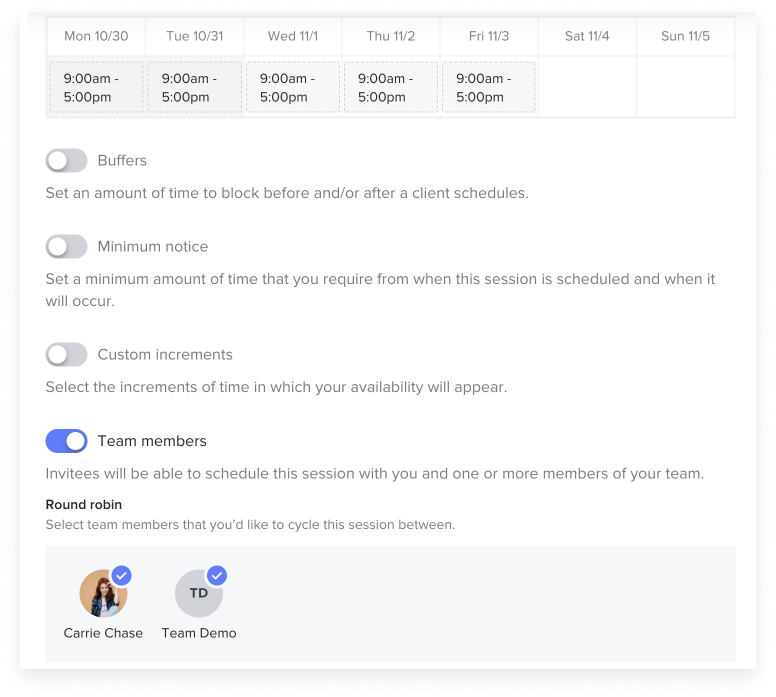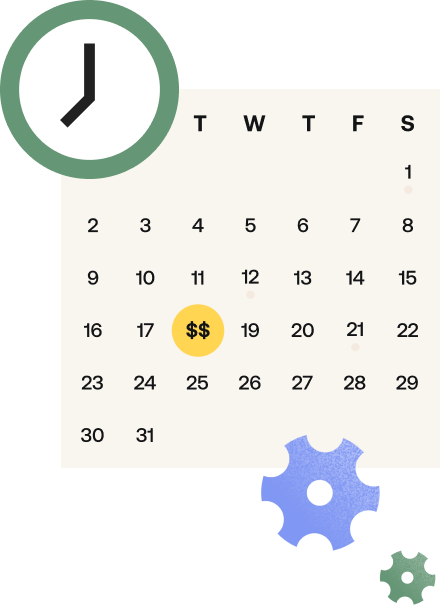Learn about round-robin scheduling, a classic approach to organizing shared time. With the right system, you can ensure your workflows are streamlined and organized among your team members.
An efficient time-sharing system maximizes each team member regardless of your business’s size. But shared calendars especially give independent businesses an edge, allowing them to work more efficiently within a fixed time period to finish tasks and move on to the next project or client. These systems also tend to scale well, so you can use them over an extended period as your business and client base grows.
One of the best ways to manage a shared business calendar is with with a round-robin scheduling approach, an effective scheduling algorithm. It’s one of the most efficient ways to distribute work so that each team member gets a fairn equal share of meetings and sales calls.
Here’s what you should know about round-robin scheduling so you can determine if it works for your team.
Jump to:
- What is round-robin scheduling?
- How can round-robin scheduling benefit a sales team?
- How to implement a round-robin scheduling method
- Defining roles and responsibilities
- Ensure everyone’s on the right page
- Break down complex tasks into smaller ones
- Optimize your calendar use
- Enable your team
What is round-robin scheduling?
Round-robin scheduling is a method used in various fields, including computer programming, where tasks or processes are handled one at a time in a queue within a specific period of time. Each task is assigned a fixed time slot and processed in turn in the context of independent businesses, it just means that each team member takes on a new meeting or client in a circular queue, one at a time.
For example, you can use it within your sales process for vetting leads. Every time new leads schedule a meeting, they’ll be assigned to team member A, then team member B, then C, and so forth.
Using a round-robin scheduler, also known as the round-robin scheduling algorithm, ensures a fair allocation of time for each team member, even with limited availability, to handle incoming meetings. Therefore, it ensures that everyone shares the same workload.
How can round-robin scheduling benefit a sales team?
One of the most common use cases for round-robin scheduling is with sales teams, where ensuring a fair share of leads is critical. Since each sales associate has the same responsibilities, each team member can equally share the responsibility of holding consultation calls or new client meetings.
Whenever a new lead inquires to schedule, they’ll be assigned to a sales associate based on the waiting queue. Employing the round-robin algorithm ensures that the team’s average response time is high, since theres virtually no waiting time to schedule a call or meeting within the allocated time slots. This is especially important for sales, as minimizing average waiting time is crucial for customer satisfaction since people with sales questions typically expect a response within 10 minutes.
You can also use round-robin scheduling for your entire team if each person shares the same tasks, like handling incoming meetings and consultation calls. With this type of workflow, there’s less context switching for your team, leading to shorter average wait times and easier scheduling for everyone.
How to implement a round-robin scheduling method
Managing shared time based on the round-robin principle seems easy enough to implement. But in reality, there are a lot of potential pitfalls that can snag your progress. Here’s some advice on how to go about using this time-sharing system for your benefit.
1. Defining roles and responsibilities
Round-robin schedules work best when you have a team that manages the same tasks. For example, three team members who all take on client projects from start to finish. This might look like a team of venue coordinators, photographers, or consultants.
Round-robin scheduling ensures fair distribution of assignments for a team like this because it doesn’t matter when each team member gets assigned. They’ll always start at the same step.
On the other hand, if your team members manage specific parts of the clients pipeline, round-robin scheduling may not work as well. If you have employees who only work on client projects but aren’t involved in the sales process, you wouldn’t want them to get assigned to leads. Instead, they’ll be assigned later once the leads book and become clients.
To determine if round-robin scheduling works for your team, start with defining your roles and responsibilities. Take the following steps as a guide:
- Determine who will be responsible for the client-facing part of the job: Who will communicate directly with customers, manage their expectations, and provide support?
- Divide up tasks based on expertise: For specialized jobs such as software development or web design, figure out which team members have more experience in those areas so that they can take charge of complex projects while others focus on simpler ones accordingly.
- Determine who will be involved in the round-robin schedule: If you have a team that manages the same tasks throughout the client pipeline, you can include everyone in a round-robin scheduling system. Otherwise, you’ll only want to provide this option for team members who communicate with leads and manage the sales process. After their work, they can manually hand off the leads to other members of your team.
2. Ensure everyone’s on the same page
Decide when you’ll be able to “round-robin” the assignments and how the time slots will be distributed for each person to complete their tasks. Also, lower-priority tasks should be factored in to ensure a balanced workload distribution. Agree on deadlines for each team member and notify them of any new additions or changes in advance so they can plan accordingly.
Let’s take, for example, a service provider who implements a round-robin sales process. A good approach is to set up a schedule that starts with the initial lead contact and ends when they are onboarded as an active client. Set internal deadlines for each step in between, for instance:
- generating leads
- sending follow-ups emails or cold calls
- setting appointments or meetings
Everyone should know which task each team member needs to complete before moving on to the next step. Implementing a system like this maintains timely communication and execution of tasks while ensuring accuracy in all assigned activities within the specified period of time.
3. Break down complex tasks into smaller ones
When setting a schedule for “round-robin” assignments, it’s essential to consider not just the optimum speed of completion but also the quality control required for the task. Who should ensure that milestones are met and timelines are adhered to within each assignment?
If a task is too difficult or problematic, assign different people at different stages. Establish clear structure and agreement concerning deadlines from day one. Team members stay accountable and productive if they avoid miscommunication due to unclear expectations. That’s the problem with working against multiple open-ended deadlines.
Pro tip
It is important to take team members’ schedules into consideration when assigning overlapping tasks between them. Guarantee time outside of work for personal life and well-being to prevent prolonged after-hours, overwork, and burnout.
4. Optimize your calendar use
Take advantage of scheduling software by color-coding (or using whatever markers work) your calendars with events or tasks based on roles or responsibilities. This way, every team receives notifications through email, so all parties involved know when something has changed concerning their project timelines and activities.
Cut down misunderstandings and give everyone more information up front to avoid surprises down the line. The main idea is to create visibility around the team’s workload and tasks, so everyone knows what’s expected of them on any given day. After all, your time-sharing system will be more effective with the efficient use of the tools that enable it. The better your calendar works, the better outcomes will result from processes based around it, leading to increased customer satisfaction. Here are some things you can try:
- Set up custom alerts – Establish customized notifications for your upcoming appointments or events, ensuring that all pertinent parties stay abreast of updates or changes promptly. This also helps to foster better relationships between you and your clients.
- Create recurring events – Automate processes like creating single-day reminders for routine tasks like monthly check-ins with clients, follow-up emails after billing cycles, and others. Doing so will save you from needing to enter the same event multiple times throughout the year manually to always keep on track.
- Prioritize visibility – Structure your calendar whereby important items are visible at a glance (e.g., color code or highlight scheduled meetings based on urgency level). This enables those managing their own workload to easily identify when something needs immediate attention. It’s better when everyone knows what takes precedence in any given week or day ahead.
Round-robin FAQs
What are the advantages of the round-robin scheduling algorithm?
Round-robin scheduling ensures fair allocation of time and workload among team members, leading to a more organized and streamlined workflow. It is particularly effective in sales teams, where it helps in equally distributing leads and consultation calls, thus improving average response times. This scheduling method also scales well as businesses grow, making it suitable for long-term use.
What is a disadvantage of using the round-robin algorithm?
A disadvantage of using the round-robin algorithm is that it may not be suitable for teams with varied roles or responsibilities. If team members manage specific parts of a project or pipeline, round-robin scheduling could lead to inefficiencies or mismatches in task assignments.
What are the limitations of round-robin scheduling?
Round-robin scheduling’s limitations include potential implementation pitfalls, such as the need for clear role definitions and balanced workload distribution. Additionally, it may not work well for teams with highly specialized tasks or when members have significantly different levels of expertise.
How do you calculate round-robin?
1. Determine the Time Quantum: Choose a fixed time quantum or time slice each process will be allowed to run before being preempted.
2. Assign Time Slots: Allocate each process a time slot equal to the time quantum in a cyclic order. If a process’s burst time is less than or equal to the time quantum, it completes within one time slot. Otherwise, it is preempted after the time quantum expires and will resume in its next turn.
3. Context Switching: Implement context switching to save the state of preempted processes and load the state of the next process in the queue.
4. Repeat the Process: Continue this process, giving each process a turn in a circular fashion until all processes complete their execution.
Is round-robin scheduling fair?
Yes, round-robin scheduling is considered fair as it ensures an equal share of meetings, sales calls, and leads among team members. It prevents any single team member from being overloaded or underutilized, promoting a balanced distribution of responsibilities.
Enable your team with HoneyBook round-robin scheduling
If you’re looking for an online booking calendar with sharing capabilities for your team, consider HoneyBook. HoneyBook is an all-in-one clientflow platform, which means it integrates scheduling with other parts of your business.
Build custom files that include branded sales collateral, scheduling, and invoicing. Or, customize the steps however you please. Everything in HoneyBook is built to support your unique business, including how you introduce scheduling to your clients.
Within your HoneyBook account, you can set up your scheduling tool to include round-robin scheduling with your team, helping to share the workload and make scheduling more efficient.





